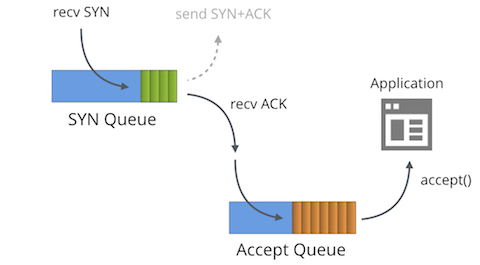SYN Queue and Accept Queue
0x00 A Single Queue or Two Queues
TCP/IP stack has two options to implement the backlog queue for a socket in the LISTEN state.
Door #1: A Single Queue
A single queue can contain connections in two different states:
- SYN RECEIVED
- ESTABLISHED
And only connections in ESTABLISHED state can be returned to the application by calling the accept() syscall.
Therefore, the length of this queue is determined by the backlog argument of the listen() syscall.
Door #2: A SYN Queue & An Accept Queue
In this case, connections in state SYN RECEIVED are added to the SYN queue, and later moved to the accept queue when their state changes to ESTABLISHED.
So, the accept queue stores only connections ready for the accept() syscall.
Unlike the previous case, the backlog argument of the listen() syscall determines the size of the accept queue.
BSD’s Choice
BSD chooses the option 1 as its behavior implementation (though it internally indeed uses two queues).
When the queue is full, instead of sending back a SYN/ACK packet in response to received SYN packet, it simply drops the SYN packet, and let the client to retry.
Modern Linux’s Choice
Since Linux 2.2, Linux uses the 2nd option and make
backlogargument for the maximum length of the accept queue/proc/sys/net/ipv4/tcp_max_syn_backlogfor the maximum length of SYN queue; and newer kernel uses/proc/sys/net/core/somaxconn(identified vianet.core.somaxconn)

By the way, from the point of the view of the client, a connection will be in state ESTABLISHED after reception of the SYN/ACK packet.
0x01 When SYN Queue is Full
When received a SYN packet but SYN queue is full, then:
- If
net.ipv4.tcp_syncookies=0, then the SYN packet is simply discarded - If
net.ipv4.tcp_syncookies=1, then
a. if the accept queue is full AND req_young_len > 1, then the SYN packet is discarded
req_young_lenis the number of connections that haven’t been retransmitted SYN/ACK packet in SYN queue
b. otherwise, generate syncookies for this SYN packet; This packet is presumed a malicous packet.
0x02 When Accept Queue is Full
When received an ACK packet, but the accept queue is full:
- If
tcp_abort_on_overflow=1, then the TCP/IP stack replies back a RST packet, then the connection is removed from the SYN queue. - If
tcp_abort_on_overflow=0, then the stack marks the connection as ACKED (i.e. ignores this ACK packet) and leaves the connection in SYN queue; soon, the timer would then go off and resend a SYN/ACK packet back, the client can resend an ACK packet again.
Or if the maximum retry limit is reached, a RST packet is still replied and the connection is removed from the SYN queue
The maximum retry number is configured by net.ipv4.tcp_synack_retries.
However, if the accept queue is full, the kernel will also impose a limit on the rate at which SYN packets are accepted: If too many SYN packets are received, some of them will be dropped.
In this case, it is up to the client to retry sending the SYN packet.
0x03 Disadvantages of Using a Single Queue
There are two major causes of the single queue that might be full.
(1) Application calling accept() is not fast enough, making completed (ESTABLISHED) connections fill the queue
(2) RTT between the server and the client is so big, that incomplete connections (in state SYN RECEIVED) fill the queue.
By using one queue, it assumes that an application is expected to tune the backlog
- not only taking into account how it intents to process newly established incoming connections,
- but also in function of traffic characteristics such as the round-trip time.
If we use two dedicated queues, the SYN queue then effectively implies ACK packets in flight; and the accept queue implies how application level handles the completed connections.